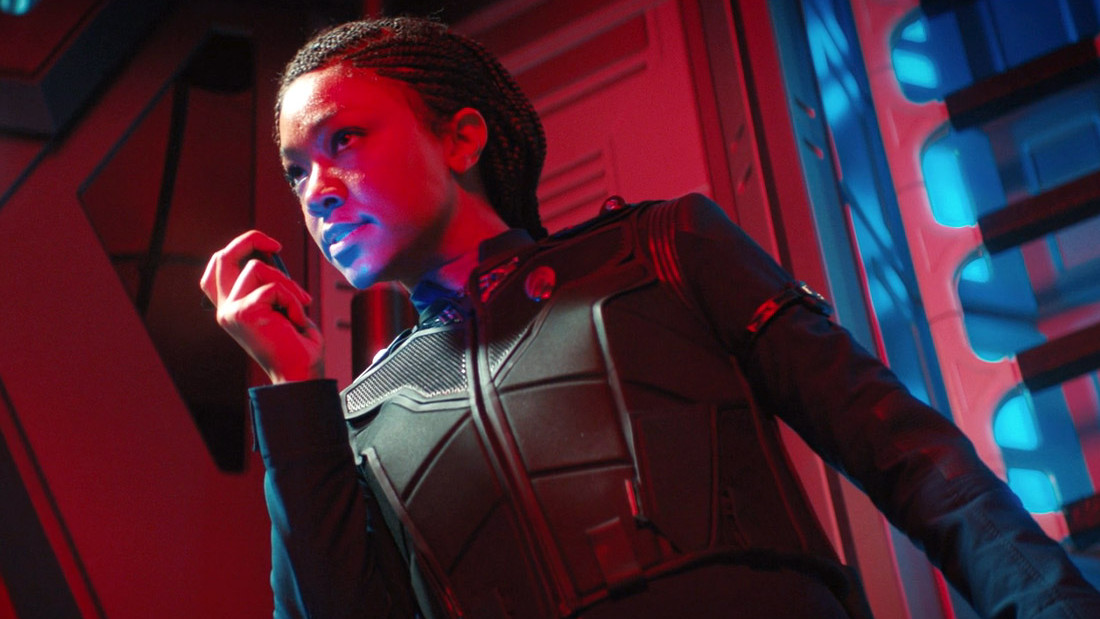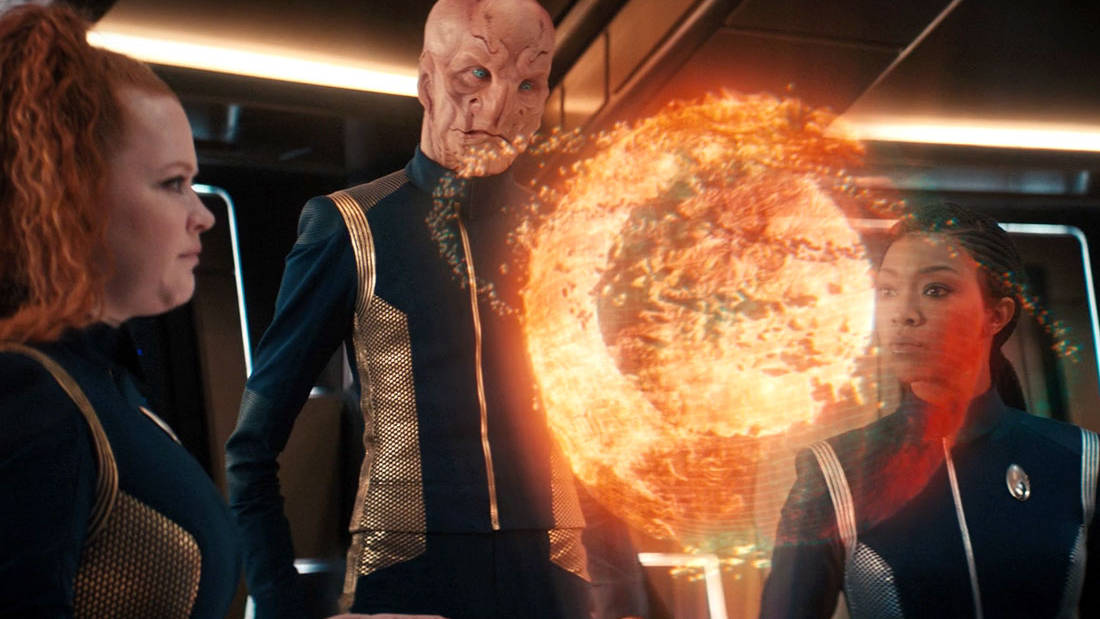Article Content
Star Trek: Discovery
‘Anomaly’: We’ll feel our way through this

As I was watching "Anomaly," I realized we’ve reached the Hallmark Greeting Card stage of the Trekkian technobabble episode. This episode is overly earnest Touchy Feely Trek taken to a level of near self-parody. It wants so badly to engage on an emotional level that it does so to the point of extreme pushiness, while failing to engage on the level I really wanted to meet it on, which was pseudo-intellectual. I wanted to understand what this anomaly was and how it kinda-sorta works, but that’s beyond the scope of this episode, which is more about how everyone feels about everything that’s happening.
Oh, sure, it pretends like it’s all about the data and the research and the science of it all, but is it really? At one point, the anomaly causes all artificial gravity to go haywire and makes everyone float above their stations before being slammed back to the deck. That’s a kinda cool visual, but most of the episode is the usual camera-shaking and sparks exploding that we’ve come to expect in Star Trek jeopardy shows for decades, and this episode pummels us with it relentlessly.
‘Discovery’ returns: Federation to the rescue, like it or not

Overall, "Kobayashi Maru" is fine, with things about it that are good, even. The plot is a straightforward if overdone peril-and-rescue scenario in which the crew must come to the aid of a Federation space station that’s spiraling out of control for mysterious reasons. This plot, naturally, makes use of the convenient device of excessive interference that renders the transporters useless (still a problem in the 32nd century!) and therefore requires a much more protracted and dangerous operation.
The rescue must be attempted by boarding the space station after flying through a violent debris field while Discovery‘s shields are endlessly buffeted and weakened and the ticking clock counts down. As these sort of Trek staples go, with the camera shaking and the sparks exploding, it’s reasonably well executed, with a certain effective intensity. But little stands out here for good or ill — which is a big improvement over much of last season’s closing episodes.
‘Discovery’ season finale: That hope has bid adieu

Discovery‘s third-season finale is an episode that alternates excessive, choppy, overwrought, and interminable action sequences with a Trekkian plot that would be perfectly fine if not for all the arbitrary technobabble and junk-science extras that are bolted onto it to explain other things. This is a mess for 50 minutes, and then exceedingly tidy for 10.
This is also an episode that cements (although it was pretty clear by the time "Su’Kal" got here) that this season is barely about anything it seemed to be when it started. The season started as "Rebuild the Fallen Federation!" (The cover art had Burnham holding a tattered Federation flag on a barren planet.) But then a few episodes later, in "Die Trying" (the season’s best episode) it became "Rediscover the Current Diminished Federation!" Now, at the end of the season, it’s "Kill Osyraa!" The season gradually went from potentially grand to painfully reductive and unambitious.
Die Hard with a Burnham

"There Is a Tide" tries to do what should’ve been done many episodes ago: some world-building within this century. It may be too little, too late, but I guess I’d rather see it attempted rather than not seeing it at all.
After having exploited Tilly’s tactical weaknesses and seizing Discovery, Osyraa takes the ship back to Starfleet Headquarters, where she uses the subterfuge to get inside the base’s shield perimeter where she demands … an audience for peaceful negotiation. I admit I did not see that coming. Turns out there’s more to Osyraa than previous episodes — in which she, say, fed her nephew to giant worms — had indicated. She wants to form an alliance between the Federation and the Emerald Chain, providing a new economic model for the Federation through its mercantiles in exchange for access to Discovery‘s spore drive, which she believes the Emerald Chain has the scientific resources to reverse-engineer and mass produce. This could be a benefit for the entire galaxy, possibly solving a lot of problems posed by everyone’s dilithium shortage.
‘Su’Kal’: Burned by the Burn

"Su’Kal" would be a reasonably okay sci-fi story in the standalone tradition of Star Trek if the circumstances were different. This is an alien contact within a holographic simulation that has some things to recommend, including notable atmosphere and characters trying to use psychology and storytelling to communicate with someone who has endured a lifetime of isolation. The problem is, this is tied into the season’s central mystery of the Burn in a way that’s crushingly disappointing. (At least, so far. Specifics are not yet revealed, although I can’t imagine any technobabble explanation could salvage this general idea.)
I’m reminded of DS9‘s "Extreme Measures," in which a big piece of the fate of the Dominion War was riding on a virtual-reality probe to explore the mind of Section 31 operative Sloan, but the device was mostly used as an excuse to give O’Brien and Bashir one last buddy adventure. The idea of one last buddy adventure was fine, but the vehicle was inappropriate and the timing was terrible.
Avoiding the Terran way

When you have the audacity to connect your story to a piece of Trekkian lore as iconic as the Guardian of Forever, the device at the center of "The City on the Edge of Forever," one of the most heralded episodes in the entire canon, you’re probably asking for trouble. You’d better put up or shut up.
They probably should’ve shut up. Or just not used the Guardian of Forever.
I’ll give them this: They tried. They put a character dilemma front and center and played it all the way through. But in the end this is oh-so-earnest, and overplayed, and frankly unearned. But we’ll get there.
‘Terra Firma, Part 1’: Sliding Doors

"Terra Firma, Part 1" works best if you think of it as the universe trying to teach its central character a lesson, like Groundhog Day did to Bill Murray. The mirror universe version of Philippa Georgiou, who has been a fish out of her universe’s water since she was brought over in the first season, has been walking around the corridors of Discovery for the past two seasons acting mostly like an insufferable jerk who is more caricature than character.
That caricature has at times been amusing (the one-liners are sometimes creative, and her aversion to all things Starfleet makes her an occasionally useful outside voice, when she’s not merely insulting everybody), but it has also become very repetitive and started to wear thin of late. But I’m suspecting now her unremitting abrasiveness this season was a deliberate ploy to set us up for this episode where she has to face the music.
‘Discovery’ succumbs to the bland in ‘Sanctuary’

Maybe I’m getting to that point in the season where my enthusiasm starts to taper off, but "The Sanctuary" really didn’t do much for me. It’s … meh. Although there are some good things spread across the ensemble here, the core of it is the epitome of mediocrity. Even though it fell short, last week’s "Unification III" at least tried to be an ambitious Star Trek episode with compelling dialogue. This week’s episode doesn’t seem to be trying to do anything at all, except recycle generic action sci-fi scenes.
Let’s start with the main plot. While I appreciate the attempt to do some world-building in this century outside the immediate orbit of Starfleet Headquarters, the concept of the Emerald Chain, the evil Orion crime syndicate, is an off-the-shelf bore led by an off-the-shelf boring villain. After his labor camp was liberated in "Scavengers," Tolor (Ian Lake) has fallen into ill standing with his syndicate boss/aunt, Osyraa (Janet Kidder), who promptly feeds him to a large creature — because if you want your villain to read as Real Bad, make sure they kill one of their own for failure. Yawn.
‘Unification III’: Dialogue, mythology, various absurdities

Naming your episode "Unification III" is a risky gambit, because it implies it’s a sequel to TNG‘s "Unification" parts I and II, in which Spock famously crossed over from TOS and appeared on TNG in an effort to bring the Vulcan and Romulan people together. On the other hand, given how average "Unification" itself ended up being, with its hype far exceeding what it actually accomplished as a story (which was, frankly, not much), maybe "Unification III" didn’t have that high a bar to clear.
I gotta say, I liked this episode, up to a point. There are things I genuinely admired about it. It manages to blend a completely personal story (Burnham’s crisis of self-identity, forcing her to confront herself) with a major Star Trek mythology piece (the status of the Vulcans and Romulans in the 32nd century) and also tie that into the season arcs involving the state of the Federation and the mystery of the Burn. This is accomplished with what may also be the most ambitiously dialogue-heavy episode of the series, which plays like a high-wire tightrope act threading the needle’s eye of intellectualism and emotionalism. A lot of things come together in some deft scenes of dialogue. At times, I found this compelling. Will it walk the tightrope or fall off?
‘Scavengers’: Go rogue or go home

Booker’s vessel — minus Book, but not his cat — appears at Starfleet Headquarters. A recording left by Book details his discovery of a "black box" from a starship destroyed in the Burn, found in the slave labor regions run by the Orion/Andorian syndicate, where Book has gone missing and may now be held captive. Such a black box could be a key piece of evidence in understanding how, and perhaps from where, the Burn originated. This is a mystery very much on Burnham’s mind, and she wants to undertake a rescue mission to find her missing friend as well as this black box of possible evidence.
The catch: Admiral Vance needs Discovery on standby for something more urgent to the greater good of Starfleet, so Saru can’t sanction a mission for one man (who, by the way, isn’t even a member of Discovery‘s crew), even if it might shed light on the Burn. So Burnham decides to go rogue and disobey a direct order to rescue Book. She recruits Georgiou ("You had me at unsanctioned mission") to help her.
